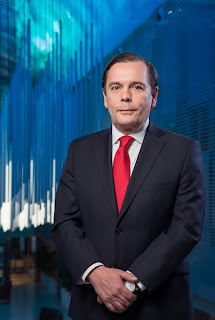Lyssiemay Annoh chats to the Madrileño making radical changes at the NH Hotels Group
Madrileño Federico J
Gonzalez Tejera, CEO of NH Hotel Group had a lot to “grin” about as he officially
launched the NH Collection in Germany on 12 May 2016. He comes to the NH Hotels Group with a
personal vision a goal for the company.
Ultimately, he wants every traveller to seek an NH Hotel first before settling for any other hotel at any destination that they travel to.
After 16 years with Procter and Gamble, 8 years at Disney,
Federico J. Gonzalez Tejera switched to the NH Hotel Group where, as Chief
Executive Officer, he manages all areas of the company with the responsibility
of complying with the strategic five-year business plan*, expanding and
developing the different areas as well as consolidating NH brands. These are exciting times for the Madrileño, who since 2015 has been a
member of the Executive Committee of the World Travel and Tourism Council
Lyssiemay Annoh, Editor-in-Chief of Executive Traveller Magazine met with Federico J Gonzalez Tejera in Berlin on 12 May 2016 in a bid to discover the real person behind the NH Group transformation.
From a multinational consumer company to Disneyland
and now you are leading the NH Hotels Group, how does it feel?
It feels good because I joined the company at an
exciting time of transformation. I am
here to see the transformation through, add value and have fun while doing so
and this is really happening.
Who is the man behind Federico J Gonzalez Tejera?
He is a curious man who is trying to do well. I like finding interesting projects to
challenge myself but above all, I like to have fun while implementing them.
What drives you?
As I have grown in my career, I am conscious of how many people I affect in my life. Leading a hotel business with a community with a diverse workforce of almost 19,000 employees of 141 different nationalities, nearly 15% of which work in countries other than their home nations, who work 7 days a week, 24 hours a day, makes me proud; because every day, these people go through experiences and I share these experiences with them.
I envisage opportunities, and then I want to get it done quickly because I want to increase the Group’s hotel assets and this makes me ambitiously impatient. My philosophy is that if you envisage something positive, why wait?As I have grown in my career, I am conscious of how many people I affect in my life. Leading a hotel business with a community with a diverse workforce of almost 19,000 employees of 141 different nationalities, nearly 15% of which work in countries other than their home nations, who work 7 days a week, 24 hours a day, makes me proud; because every day, these people go through experiences and I share these experiences with them.
What personal achievement or legacy do you want to
leave with the NH Hotels Group?
I am revitalizing a company with over 18 million
employees all full of pride and very passionate about their jobs. I have been fortunate to manage a transformation
that has provided adequate financial tools to enable us to create a picture of
the future. At the end of it all, my ambition is that when
anyone travels for leisure or business, they will always ask themselves if
there is an NH Hotel in the area first before going for a second option. This goal summarizes my ambition from the
beginning of the process and the employees agree with me and this makes them
happy.
What is the rationale behind the VIP Level at the NH
Collection hotels?
We created the VIP Level because for me, luxury is
subjective to the user. Our VIP status
is a matter of segmentation to the user.
By this I mean that a 3-star hotel could be luxury to someone who
usually uses 1-star hotels. Many of our
NH hotels especially the NH Collection could be classified as a five-star hotel
but businesses today do not want to be seen as using five-star properties
especially as they are conscious of sending the wrong messages by allowing
employees to stay in five-star properties for business purposes. For this reason, and in order not to lose our
business clientele, we created a VIP status to offer them a little more. It is all a matter of expectations and the
service is available at all our NH Collection hotels.
Do you seek to surprise your guests?
Yes, all the time.
I have an obsession to excel with our basics so as to achieve the
surprise element. We do this very well with our showers for example where we
provide large shower heads in most rooms or rain showers in some of the rooms. We also use symbols on the telephone to facilitate
dialing the reception desk for example.
There is also an element of surprise with the lighting and
televisions. As a matter of fact, I tend
to surprise myself by trying some of the products we have developed in the
hotel in my own home to see how it feels.
Finally, if you
had to change anything at all in the world, what would it be?
It will have to be starvation. I don’t have a plan yet, but I will work on
it. I am also happy to work with anyone
who has a plan.
*Under
the NH Hotel Group five-year plan drawn in 2014, CEO Federico J Gonzalez Tejera
will concentrate particularly on:
- 1. Clear segmentation of the hotel portfolio under the new overall brand
- 2. Promotion of customer satisfaction through high quality products and services
- 3. Increase in brand recognition though enhanced communication activities in the context of a comprehensive advertising campaign for NH hotels
- 4. Optimization regarding technical equipment













